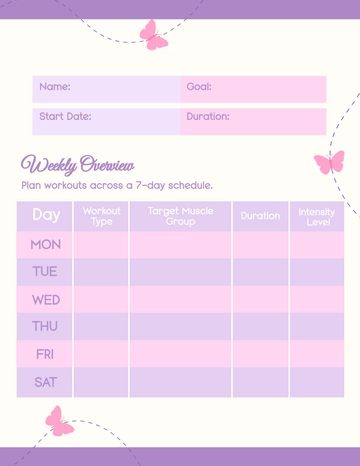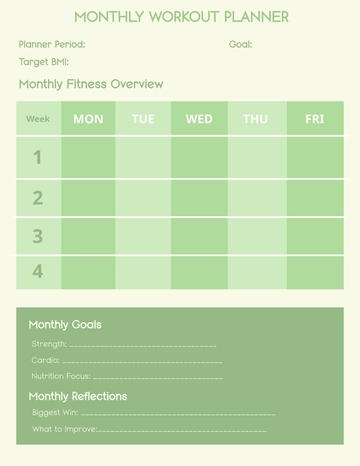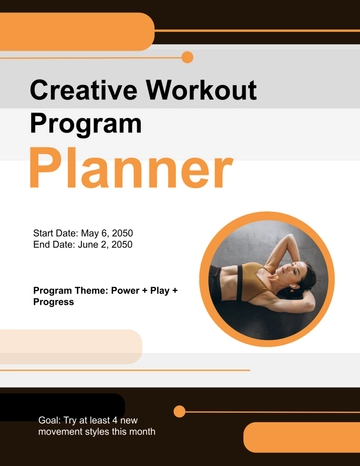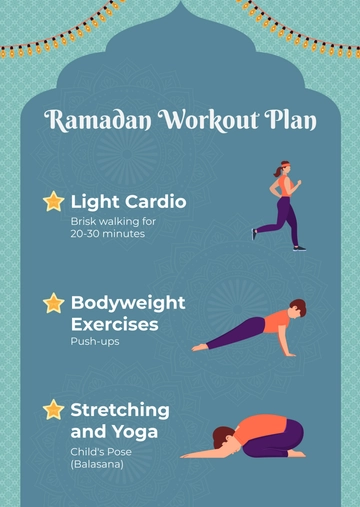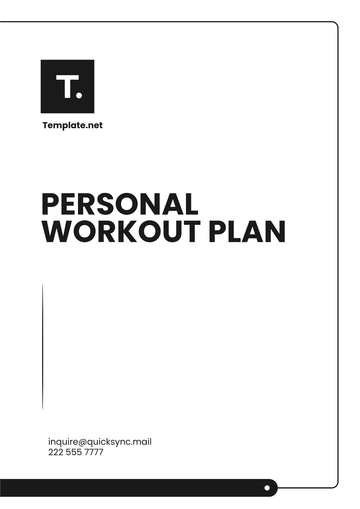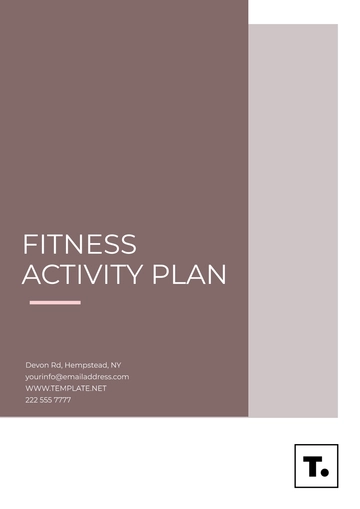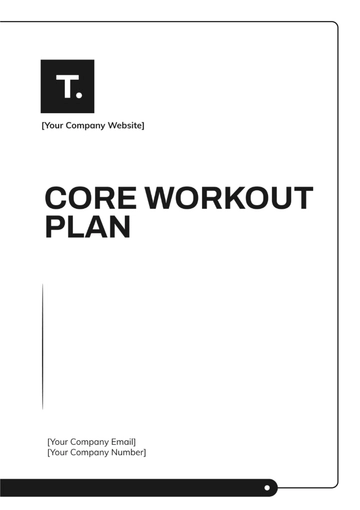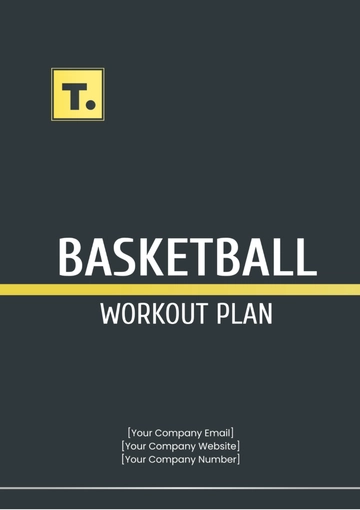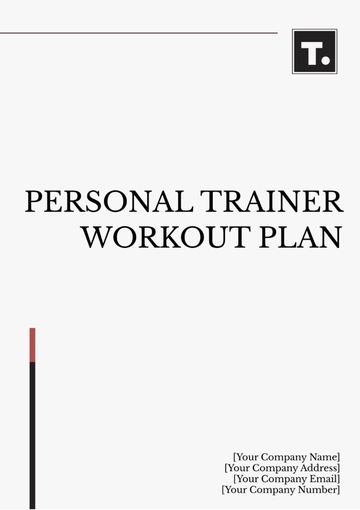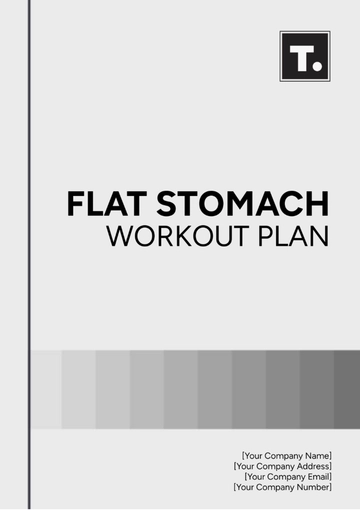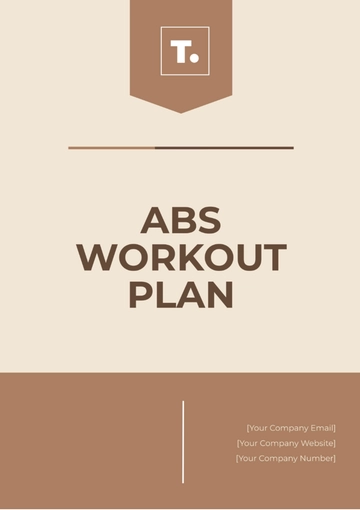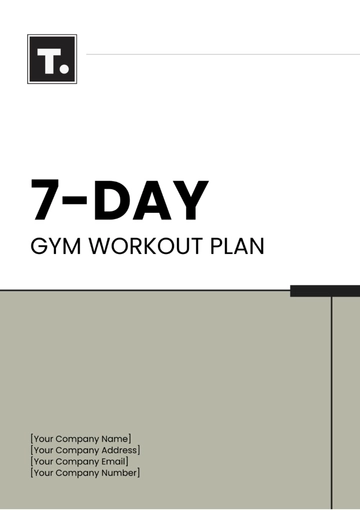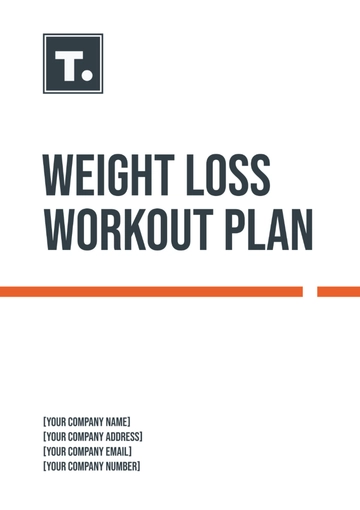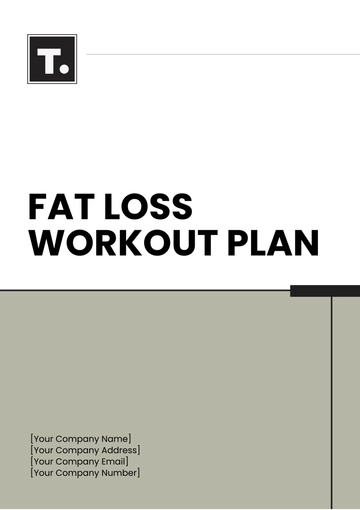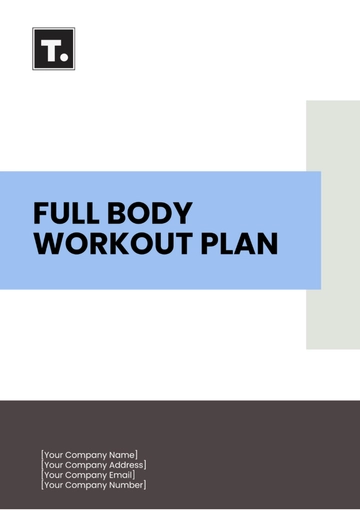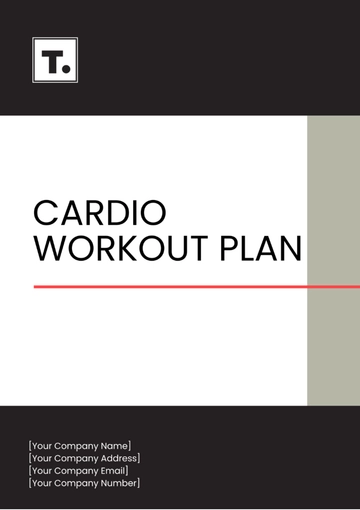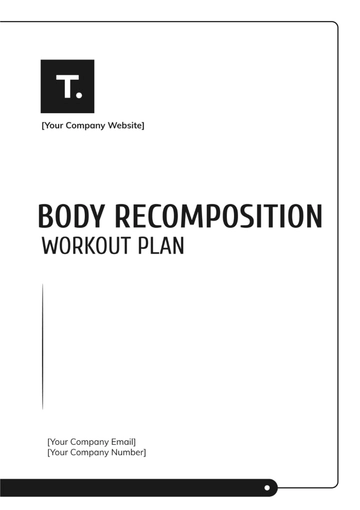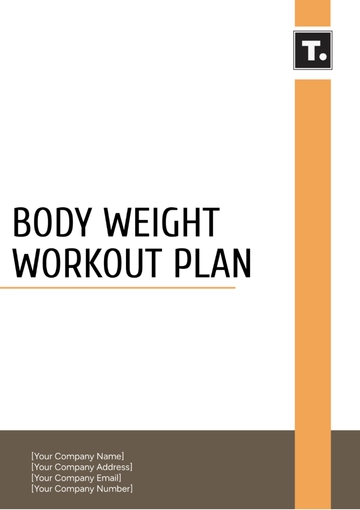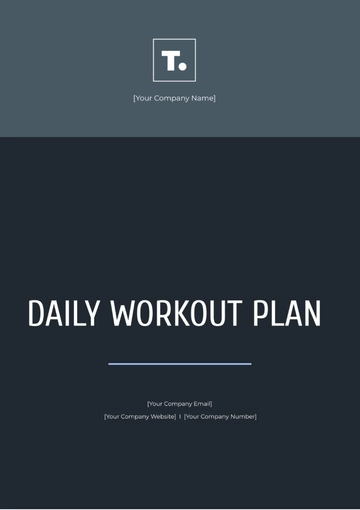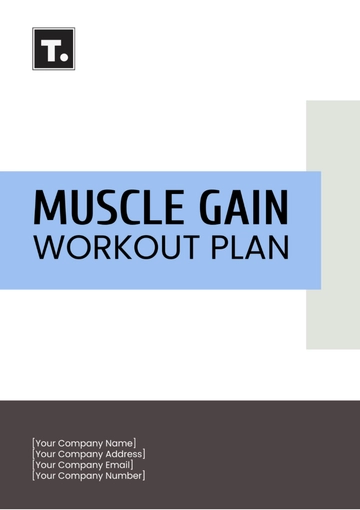Free Gym Fitness Plan

I. Executive Summary
The Fitness Plan of [Your Company Name] is designed to provide clients with a comprehensive approach to achieving their fitness goals. This plan includes structured workout routines, nutritional guidance, progress tracking, and motivational strategies to ensure clients remain engaged and committed. By following this plan, clients can expect to improve their physical health, increase their strength, and achieve a balanced fitness regimen tailored to their needs.
This plan addresses the critical aspects of a successful fitness journey. It includes goal setting, workout routines, nutritional guidance, progress tracking, and more. It details specific instructions, tables, and insights to support clients at every stage of their fitness journey.
The ultimate aim of this fitness plan is to create a sustainable and enjoyable fitness experience that promotes long-term health and well-being. By providing clear guidance and consistent support, [Your Company Name] aims to help clients achieve their fitness aspirations and maintain a healthy lifestyle.
II. Goal Setting
A. Defining Fitness Goals
Identify Primary Goals: Determine the main fitness objectives, such as weight loss, muscle gain, or improved endurance. This helps in creating a focused and effective fitness plan.
Set SMART Goals: Ensure goals are Specific, Measurable, Achievable, Relevant, and Time-bound. This provides clear direction and motivation for clients.
Short-Term vs. Long-Term Goals: Distinguish between short-term and long-term goals to create a balanced plan that includes immediate wins and long-term achievements.
Setting clear and achievable fitness goals is the first step in any fitness journey. Identifying primary objectives helps in tailoring the fitness plan to individual needs. Using the SMART criteria ensures that goals are realistic and trackable, enhancing motivation and accountability. Differentiating between short-term and long-term goals allows for a balanced approach, providing clients with both immediate satisfaction and sustained progress.
B. Assessment and Baseline Measurement
Physical Assessments: Conduct initial assessments, including body composition analysis, strength tests, and endurance evaluations. This establishes a starting point for progress tracking.
Health Screening: Perform a health screening to identify any medical conditions or limitations that need to be considered in the fitness plan.
Fitness History: Review the client’s fitness history, including previous workout routines and any injuries. This helps in designing a safe and effective fitness plan.
Initial assessments provide valuable data to tailor the fitness plan to individual needs. Physical assessments give insight into current fitness levels, while health screenings ensure safety and accommodate any medical conditions. Understanding the client's fitness history helps in avoiding past mistakes and leveraging successful strategies.
C. Motivation and Commitment
Setting Milestones: Establish regular milestones to keep clients motivated and focused on their progress. This breaks down long-term goals into manageable steps.
Tracking Progress: Implement a system for tracking progress, such as a fitness app or journal. This provides visual proof of improvement and keeps clients accountable.
Support System: Encourage clients to build a support system, including family, friends, or fitness communities. This provides encouragement and shared motivation.
Motivation and commitment are crucial for long-term success. Setting milestones provides short-term targets that make the fitness journey less daunting. Tracking progress visually can boost morale and help maintain commitment. A strong support system can offer emotional and motivational support, making the journey more enjoyable.
III. Workout Routines
The following table outlines different workout routines tailored for various fitness goals. Each routine includes specific exercises, frequency, and duration:
Fitness Goal | Exercises | Frequency | Duration |
|---|---|---|---|
Weight Loss | Cardio, HIIT, Strength Training | 5 days/week | 45-60 mins |
Muscle Gain | Strength Training, Hypertrophy | 4 days/week | 60-75 mins |
Endurance | Cardio, Circuit Training | 4 days/week | 60 mins |
Flexibility | Yoga, Stretching | 3 days/week | 30-45 mins |
A. Weight Loss Routine
Cardio Workouts: Include running, cycling, and swimming to burn calories and improve cardiovascular health. Aim for 30-45 minutes per session.
HIIT (High-Intensity Interval Training): Incorporate HIIT sessions to boost metabolism and burn fat. Sessions should last 20-30 minutes, focusing on short bursts of intense activity followed by rest.
Strength Training: Perform full-body strength training exercises to build muscle and increase metabolism. Include exercises like squats, deadlifts, and bench presses.
Weight loss routines should focus on burning calories and boosting metabolism. Cardio workouts improve cardiovascular health and aid in calorie expenditure. HIIT is effective for fat loss due to its high-intensity nature and metabolic benefits. Strength training is essential for building muscle, which increases resting metabolic rate and aids in weight loss.
B. Muscle Gain Routine
Compound Movements: Focus on compound exercises like squats, deadlifts, and bench presses to target multiple muscle groups and stimulate growth.
Progressive Overload: Gradually increase the weight and intensity of workouts to continually challenge muscles and promote growth.
Hypertrophy Training: Include hypertrophy-specific workouts with moderate to high reps (8-12) and multiple sets (3-5) to maximize muscle growth.
Muscle gain routines should emphasize strength and hypertrophy training. Compound movements are crucial for stimulating multiple muscle groups and maximizing efficiency. Progressive overload ensures continuous muscle adaptation and growth. Hypertrophy training focuses on muscle size by incorporating higher reps and multiple sets.
C. Endurance Routine
Steady-State Cardio: Incorporate long-duration, steady-state cardio sessions such as running or cycling to build endurance. Aim for 45-60 minutes per session.
Circuit Training: Use circuit training to improve muscular endurance and cardiovascular fitness simultaneously. Include a variety of exercises with minimal rest.
Interval Training: Include interval training sessions to enhance both aerobic and anaerobic endurance. Alternate between high-intensity and low-intensity intervals.
Endurance routines should focus on improving cardiovascular and muscular endurance. Steady-state cardio builds aerobic capacity and stamina. Circuit training enhances overall fitness by combining strength and cardio exercises. Interval training boosts both aerobic and anaerobic endurance, making it a comprehensive approach to endurance training.
D. Flexibility Routine
Yoga: Incorporate yoga sessions to improve flexibility, balance, and mental well-being. Include a mix of dynamic and static poses.
Dynamic Stretching: Perform dynamic stretching before workouts to prepare muscles and joints for activity. This helps prevent injuries and improves performance.
Static Stretching: Include static stretching post-workout to enhance muscle flexibility and aid recovery. Hold each stretch for 20-30 seconds.
Flexibility routines should include a combination of dynamic and static stretching. Yoga enhances flexibility and balance while promoting mental relaxation. Dynamic stretching is effective for warming up muscles and preventing injuries. Static stretching post-workout aids in muscle recovery and maintains flexibility.
IV. Nutritional Guidance
Proper nutrition is essential for achieving optimal results and maintaining overall health. The following table presents recommended nutritional guidelines to support various fitness goals:
Fitness Goal | Macronutrient Ratio | Key Foods | Supplements |
|---|---|---|---|
Weight Loss | 40% Carbs, 30% Protein, 30% Fat | Lean meats, vegetables, whole grains | Multivitamins, Protein Powder |
Muscle Gain | 50% Carbs, 30% Protein, 20% Fat | Lean meats, rice, oats, legumes | Creatine, BCAAs |
Endurance | 60% Carbs, 25% Protein, 15% Fat | Fruits, vegetables, whole grains | Electrolytes, BCAAs |
Flexibility | Balanced diet | Fruits, vegetables, lean meats | Multivitamins |
A. Weight Loss Nutrition
Macronutrient Balance: Focus on a macronutrient ratio of 40% carbs, 30% protein, and 30% fat. This supports energy needs and muscle maintenance.
Caloric Deficit: Create a caloric deficit by consuming fewer calories than burned. This is essential for weight loss.
Healthy Foods: Prioritize lean meats, vegetables, and whole grains to ensure nutrient-dense meals. Avoid processed foods and sugars.
Weight loss nutrition should focus on maintaining a balanced macronutrient ratio to support energy levels and muscle maintenance. Creating a caloric deficit is crucial for weight loss, requiring careful monitoring of calorie intake. Prioritizing healthy, nutrient-dense foods helps in achieving weight loss goals while maintaining overall health.
B. Muscle Gain Nutrition
High-Carb Diet: Emphasize a diet high in carbohydrates (50% of total intake) to fuel intense workouts and support muscle growth.
Protein Intake: Ensure adequate protein intake (30% of total intake) to repair and build muscle tissue. Include sources like lean meats, legumes, and protein supplements.
Healthy Fats: Include healthy fats (20% of total intake) to support hormone production and overall health. Sources include avocados, nuts, and olive oil.
Muscle gain nutrition requires a high-carbohydrate diet to provide the necessary energy for intense workouts. Adequate protein intake is essential for muscle repair and growth. Including healthy fats supports hormone production and overall well-being, creating a balanced diet that promotes muscle gain.
C. Endurance Nutrition
Carbohydrate Loading: Focus on a high carbohydrate intake (60% of total intake) to maintain energy levels during prolonged activities. Include fruits, vegetables, and whole grains.
Hydration: Ensure proper hydration by drinking water and consuming electrolytes. This prevents dehydration and maintains performance.
Protein for Recovery: Include sufficient protein (25% of total intake) to aid in muscle repair and recovery. Sources include lean meats, legumes, and protein supplements.
Endurance nutrition emphasizes high carbohydrate intake to sustain energy levels during extended activities. Proper hydration is critical to prevent dehydration and maintain performance. Including sufficient protein aids in muscle recovery, ensuring continued endurance and stamina.
D. Flexibility Nutrition
Balanced Diet: Maintain a balanced diet with a variety of fruits, vegetables, lean meats, and whole grains. This supports overall health and flexibility.
Hydration: Drink plenty of water to keep muscles hydrated and prevent cramps. Proper hydration aids in maintaining flexibility.
Antioxidants: Include antioxidant-rich foods like berries, nuts, and green leafy vegetables. Antioxidants help reduce inflammation and promote recovery.
Flexibility nutrition involves maintaining a balanced diet to support overall health and muscle function. Proper hydration is essential for preventing cramps and maintaining muscle elasticity. Including antioxidant-rich foods helps reduce inflammation and supports recovery, promoting flexibility.
V. Progress Tracking
Regular monitoring helps in adjusting the fitness plan as needed and maintaining motivation. The following table highlights the key metrics for tracking progress:
Metric | Measurement Tool | Frequency | Importance |
|---|---|---|---|
Weight | Scale | Weekly | Tracks overall weight changes |
Body Fat Percentage | Calipers or Body Fat Scale | Monthly | Measures fat loss and muscle gain |
Strength Levels | Performance Tests (e.g., 1RM) | Monthly | Tracks improvements in strength |
Endurance Levels | Timed Tests (e.g., 5K run) | Monthly | Measures improvements in endurance |
Flexibility | Sit-and-Reach Test | Monthly | Tracks improvements in flexibility |
A. Weight Tracking
Weekly Weigh-Ins: Conduct weekly weigh-ins to monitor weight changes. This helps in assessing the effectiveness of the fitness plan.
Consistency: Weigh-in at the same time and under the same conditions each week for accurate tracking.
Adjustments: Adjust the fitness and nutrition plan based on weight trends. This ensures continuous progress toward fitness goals.
Regular weight tracking provides a clear picture of progress and helps in adjusting the fitness plan as needed. Consistency in weighing conditions ensures accurate tracking, while adjustments based on weight trends keep the plan effective and aligned with goals.
B. Body Fat Percentage
Monthly Measurements: Measure body fat percentage monthly using calipers or a body fat scale. This tracks fat loss and muscle gain.
Accuracy: Ensure accurate measurements by using the same method and conditions each time. Consistent measurements provide reliable data.
Progress Evaluation: Evaluate progress and make necessary adjustments to the fitness and nutrition plan. This helps in achieving a leaner physique.
Tracking body fat percentage provides insight into fat loss and muscle gain. Monthly measurements ensure regular monitoring, while consistent methods guarantee accuracy. Evaluating progress based on body fat percentage helps in refining the fitness plan for optimal results.
C. Strength Levels
Performance Tests: Conduct performance tests like one-rep max (1RM) monthly to track strength improvements. This measures progress in lifting capacity.
Incremental Goals: Set incremental strength goals to keep clients motivated and focused on improvement.
Adjust Workouts: Adjust workout routines based on strength test results. This ensures continued progression and avoids plateaus.
Strength level tracking through performance tests provides tangible proof of progress. Setting incremental goals maintains motivation, while adjusting workouts based on test results ensures continuous improvement and prevents stagnation.
D. Endurance Levels
Timed Tests: Perform timed tests, such as a 5K run, monthly to measure endurance improvements. This tracks cardiovascular fitness.
Benchmarking: Use initial test results as a benchmark for future comparisons. This provides a clear indicator of progress.
Training Adjustments: Adjust training routines based on endurance test results. This ensures continued improvement in cardiovascular fitness.
Tracking endurance levels through timed tests provides a clear measure of cardiovascular fitness. Benchmarking initial results allows for accurate progress comparisons, while training adjustments based on test results ensure continuous improvement.
E. Flexibility
Flexibility Tests: Conduct flexibility tests, such as the sit-and-reach test, monthly. This measures improvements in muscle elasticity and joint mobility.
Consistency: Perform tests under the same conditions for accurate tracking.
Routine Adjustments: Adjust stretching and flexibility routines based on test results. This ensures continuous improvement in flexibility.
Tracking flexibility through standardized tests provides insight into muscle elasticity and joint mobility. Consistent testing conditions ensure accurate results, while routine adjustments based on test results promote ongoing flexibility improvements.
VI. Motivation and Support
Consistent motivation and support are crucial for long-term success. The following table outlines strategies for maintaining motivation and providing support throughout the fitness journey:
Strategy | Description | Frequency | Importance |
|---|---|---|---|
Milestone Celebrations | Celebrate achievements and milestones | Monthly | Boosts motivation and confidence |
Progress Meetings | Regular check-ins with a coach | Bi-Weekly | Provides accountability and guidance |
Support Groups | Join fitness groups or communities | Weekly | Offers social support and encouragement |
Reward System | Implement a reward system for progress | Ongoing | Keeps clients engaged and motivated |
A. Milestone Celebrations
Achievement Recognition: Recognize and celebrate achievements and milestones. This boosts motivation and confidence.
Rewards: Offer rewards for reaching significant milestones, such as new workout gear or a massage. This provides additional motivation.
Public Acknowledgment: Share client achievements on social media or within the gym community. This creates a sense of pride and accomplishment.
Celebrating milestones is a powerful motivator, boosting confidence and encouraging continued effort. Offering tangible rewards adds extra incentive, while public acknowledgment fosters a sense of community and recognition.
B. Progress Meetings
Regular Check-Ins: Schedule bi-weekly check-ins with a coach to discuss progress and challenges. This provides accountability and personalized guidance.
Feedback and Adjustments: Use check-ins to provide feedback and make necessary adjustments to the fitness plan. This ensures the plan remains effective and aligned with goals.
Support and Encouragement: Offer support and encouragement during meetings to keep clients motivated and focused on their goals.
Regular progress meetings with a coach provide essential accountability and personalized guidance. These check-ins allow for timely feedback and adjustments to the fitness plan, ensuring continuous progress. Support and encouragement during meetings help maintain motivation and focus.
C. Support Groups
Fitness Communities: Join fitness groups or communities for social support and encouragement. This creates a sense of belonging and shared motivation.
Group Activities: Participate in group activities such as classes or group workouts. This makes fitness more enjoyable and less isolating.
Peer Support: Encourage clients to find workout buddies for mutual support and accountability. This enhances commitment and enjoyment.
Support groups and fitness communities provide social support and encouragement, enhancing motivation and adherence to the fitness plan. Group activities make fitness more enjoyable, while peer support fosters mutual accountability and commitment.
D. Reward System
Incentive Programs: Implement incentive programs that reward clients for progress, such as earning points for workouts completed or goals achieved. This keeps clients engaged and motivated.
Personal Rewards: Encourage clients to set personal rewards for reaching their goals, such as a spa day or a new outfit. This provides additional motivation.
Progress Tracking: Use a tracking system to monitor progress and reward achievements. This provides visual proof of success and keeps clients motivated.
A reward system adds an extra layer of motivation, keeping clients engaged and committed to their fitness journey. Incentive programs and personal rewards provide tangible incentives, while progress tracking offers visual proof of success and continuous motivation.
VII. Progress Tracking
Regular monitoring helps in adjusting the fitness plan as needed and maintaining motivation. The following table outlines the key metrics for tracking progress:
Metric | Measurement Tool | Frequency | Importance |
|---|---|---|---|
Weight | Scale | Weekly | Tracks overall weight changes |
Body Fat Percentage | Calipers or Body Fat Scale | Monthly | Measures fat loss and muscle gain |
Strength Levels | Performance Tests (e.g., 1RM) | Monthly | Tracks improvements in strength |
Endurance Levels | Timed Tests (e.g., 5K run) | Monthly | Measures improvements in endurance |
Flexibility | Sit-and-Reach Test | Monthly | Tracks improvements in flexibility |
A. Weight Tracking
Weekly Weigh-Ins: Conduct weekly weigh-ins to monitor weight changes. This helps in assessing the effectiveness of the fitness plan.
Consistency: Weigh-in at the same time and under the same conditions each week for accurate tracking.
Adjustments: Adjust the fitness and nutrition plan based on weight trends. This ensures continuous progress toward fitness goals.
Regular weight tracking provides a clear picture of progress and helps in adjusting the fitness plan as needed. Consistency in weighing conditions ensures accurate tracking, while adjustments based on weight trends keep the plan effective and aligned with goals.
B. Body Fat Percentage
Monthly Measurements: Measure body fat percentage monthly using calipers or a body fat scale. This tracks fat loss and muscle gain.
Accuracy: Ensure accurate measurements by using the same method and conditions each time. Consistent measurements provide reliable data.
Progress Evaluation: Evaluate progress and make necessary adjustments to the fitness and nutrition plan. This helps in achieving a leaner physique.
Tracking body fat percentage provides insight into fat loss and muscle gain. Monthly measurements ensure regular monitoring, while consistent methods guarantee accuracy. Evaluating progress based on body fat percentage helps in refining the fitness plan for optimal results.
C. Strength Levels
Performance Tests: Conduct performance tests like one-rep max (1RM) monthly to track strength improvements. This measures progress in lifting capacity.
Incremental Goals: Set incremental strength goals to keep clients motivated and focused on improvement.
Adjust Workouts: Adjust workout routines based on strength test results. This ensures continued progression and avoids plateaus.
Strength level tracking through performance tests provides tangible proof of progress. Setting incremental goals maintains motivation, while adjusting workouts based on test results ensures continuous improvement and prevents stagnation.
D. Endurance Levels
Timed Tests: Perform timed tests, such as a 5K run, monthly to measure endurance improvements. This tracks cardiovascular fitness.
Benchmarking: Use initial test results as a benchmark for future comparisons. This provides a clear indicator of progress.
Training Adjustments: Adjust training routines based on endurance test results. This ensures continued improvement in cardiovascular fitness.
Tracking endurance levels through timed tests provides a clear measure of cardiovascular fitness. Benchmarking initial results allows for accurate progress comparisons, while training adjustments based on test results ensure continuous improvement.
E. Flexibility
Flexibility Tests: Conduct flexibility tests, such as the sit-and-reach test, monthly. This measures improvements in muscle elasticity and joint mobility.
Consistency: Perform tests under the same conditions for accurate tracking.
Routine Adjustments: Adjust stretching and flexibility routines based on test results. This ensures continuous improvement in flexibility.
Tracking flexibility through standardized tests provides insight into muscle elasticity and joint mobility. Consistent testing conditions ensure accurate results, while routine adjustments based on test results promote ongoing flexibility improvements.
VIII. Motivation and Support
Consistent motivation and support are crucial for long-term success. The following table presents strategies for maintaining motivation and providing support throughout the fitness journey:
Strategy | Description | Frequency | Importance |
|---|---|---|---|
Milestone Celebrations | Celebrate achievements and milestones | Monthly | Boosts motivation and confidence |
Progress Meetings | Regular check-ins with a coach | Bi-Weekly | Provides accountability and guidance |
Support Groups | Join fitness groups or communities | Weekly | Offers social support and encouragement |
Reward System | Implement a reward system for progress | Ongoing | Keeps clients engaged and motivated |
A. Milestone Celebrations
Achievement Recognition: Recognize and celebrate achievements and milestones. This boosts motivation and confidence.
Rewards: Offer rewards for reaching significant milestones, such as new workout gear or a massage. This provides additional motivation.
Public Acknowledgment: Share client achievements on social media or within the gym community. This creates a sense of pride and accomplishment.
Celebrating milestones is a powerful motivator, boosting confidence and encouraging continued effort. Offering tangible rewards adds extra incentive, while public acknowledgment fosters a sense of community and recognition.
B. Progress Meetings
Regular Check-Ins: Schedule bi-weekly check-ins with a coach to discuss progress and challenges. This provides accountability and personalized guidance.
Feedback and Adjustments: Use check-ins to provide feedback and make necessary adjustments to the fitness plan. This ensures the plan remains effective and aligned with goals.
Support and Encouragement: Offer support and encouragement during meetings to keep clients motivated and focused on their goals.
Regular progress meetings with a coach provide essential accountability and personalized guidance. These check-ins allow for timely feedback and adjustments to the fitness plan, ensuring continuous progress. Support and encouragement during meetings help maintain motivation and focus.
C. Support Groups
Fitness Communities: Join fitness groups or communities for social support and encouragement. This creates a sense of belonging and shared motivation.
Group Activities: Participate in group activities such as classes or group workouts. This makes fitness more enjoyable and less isolating.
Peer Support: Encourage clients to find workout buddies for mutual support and accountability. This enhances commitment and enjoyment.
Support groups and fitness communities provide social support and encouragement, enhancing motivation and adherence to the fitness plan. Group activities make fitness more enjoyable, while peer support fosters mutual accountability and commitment.
D. Reward System
Incentive Programs: Implement incentive programs that reward clients for progress, such as earning points for workouts completed or goals achieved. This keeps clients engaged and motivated.
Personal Rewards: Encourage clients to set personal rewards for reaching their goals, such as a spa day or a new outfit. This provides additional motivation.
Progress Tracking: Use a tracking system to monitor progress and reward achievements. This provides visual proof of success and keeps clients motivated.
A reward system adds an extra layer of motivation, keeping clients engaged and committed to their fitness journey. Incentive programs and personal rewards provide tangible incentives, while progress tracking offers visual proof of success and continuous motivation.
IX. Conclusion and Next Steps
A. Conclusion
This Fitness Plan of [Your Company Name] offers a structured and comprehensive approach to achieving various fitness goals. By integrating goal setting, tailored workout routines, nutritional guidance, progress tracking, and motivational strategies, clients can enjoy a well-rounded and effective fitness journey. This plan is designed to support clients at every stage, ensuring that they have the tools and resources necessary for success.
The ultimate goal of this fitness plan is to promote long-term health and well-being. By providing clear guidance and consistent support, [Your Company Name] is committed to helping clients achieve their fitness aspirations and maintain a healthy lifestyle. With dedication and persistence, clients can look forward to significant improvements in their physical health and overall fitness.
B. Next Steps
To ensure the successful implementation of this plan, the following steps are recommended:
Initial Assessments: Conduct comprehensive initial assessments for all clients to establish baselines and customize fitness plans.
Regular Check-Ins: Schedule bi-weekly progress meetings with clients to monitor their progress and make necessary adjustments to their fitness plans.
Nutritional Workshops: Organize monthly nutritional workshops to educate clients on healthy eating habits and the importance of nutrition in their fitness journey.
Group Activities: Promote and organize group fitness activities to foster a sense of community and provide additional motivation for clients.
Progress Tracking Tools: Encourage the use of progress tracking tools, such as fitness apps or journals, to help clients stay accountable and motivated.
By following these steps, [Your Company Name] can create a supportive and effective environment that helps clients achieve their fitness goals. This comprehensive fitness plan, combined with dedicated support and regular monitoring, will ensure that clients stay motivated and on track towards a healthier lifestyle.
- 100% Customizable, free editor
- Access 1 Million+ Templates, photo’s & graphics
- Download or share as a template
- Click and replace photos, graphics, text, backgrounds
- Resize, crop, AI write & more
- Access advanced editor
Develop a tailored fitness plan with the Gym Fitness Plan Template! Available on Template.net, this template is editable to accommodate different fitness goals and regimes. It is customizable to fit the needs of clients. The AI Editor Tool aids in creating a personalized plan, ensuring clients achieve their fitness objectives!
You may also like
- Finance Plan
- Construction Plan
- Sales Plan
- Development Plan
- Career Plan
- Budget Plan
- HR Plan
- Education Plan
- Transition Plan
- Work Plan
- Training Plan
- Communication Plan
- Operation Plan
- Health And Safety Plan
- Strategy Plan
- Professional Development Plan
- Advertising Plan
- Risk Management Plan
- Restaurant Plan
- School Plan
- Nursing Home Patient Care Plan
- Nursing Care Plan
- Plan Event
- Startup Plan
- Social Media Plan
- Staffing Plan
- Annual Plan
- Content Plan
- Payment Plan
- Implementation Plan
- Hotel Plan
- Workout Plan
- Accounting Plan
- Campaign Plan
- Essay Plan
- 30 60 90 Day Plan
- Research Plan
- Recruitment Plan
- 90 Day Plan
- Quarterly Plan
- Emergency Plan
- 5 Year Plan
- Gym Plan
- Personal Plan
- IT and Software Plan
- Treatment Plan
- Real Estate Plan
- Law Firm Plan
- Healthcare Plan
- Improvement Plan
- Media Plan
- 5 Year Business Plan
- Learning Plan
- Marketing Campaign Plan
- Travel Agency Plan
- Cleaning Services Plan
- Interior Design Plan
- Performance Plan
- PR Plan
- Birth Plan
- Life Plan
- SEO Plan
- Disaster Recovery Plan
- Continuity Plan
- Launch Plan
- Legal Plan
- Behavior Plan
- Performance Improvement Plan
- Salon Plan
- Security Plan
- Security Management Plan
- Employee Development Plan
- Quality Plan
- Service Improvement Plan
- Growth Plan
- Incident Response Plan
- Basketball Plan
- Emergency Action Plan
- Product Launch Plan
- Spa Plan
- Employee Training Plan
- Data Analysis Plan
- Employee Action Plan
- Territory Plan
- Audit Plan
- Classroom Plan
- Activity Plan
- Parenting Plan
- Care Plan
- Project Execution Plan
- Exercise Plan
- Internship Plan
- Software Development Plan
- Continuous Improvement Plan
- Leave Plan
- 90 Day Sales Plan
- Advertising Agency Plan
- Employee Transition Plan
- Smart Action Plan
- Workplace Safety Plan
- Behavior Change Plan
- Contingency Plan
- Continuity of Operations Plan
- Health Plan
- Quality Control Plan
- Self Plan
- Sports Development Plan
- Change Management Plan
- Ecommerce Plan
- Personal Financial Plan
- Process Improvement Plan
- 30-60-90 Day Sales Plan
- Crisis Management Plan
- Engagement Plan
- Execution Plan
- Pandemic Plan
- Quality Assurance Plan
- Service Continuity Plan
- Agile Project Plan
- Fundraising Plan
- Job Transition Plan
- Asset Maintenance Plan
- Maintenance Plan
- Software Test Plan
- Staff Training and Development Plan
- 3 Year Plan
- Brand Activation Plan
- Release Plan
- Resource Plan
- Risk Mitigation Plan
- Teacher Plan
- 30 60 90 Day Plan for New Manager
- Food Safety Plan
- Food Truck Plan
- Hiring Plan
- Quality Management Plan
- Wellness Plan
- Behavior Intervention Plan
- Bonus Plan
- Investment Plan
- Maternity Leave Plan
- Pandemic Response Plan
- Succession Planning
- Coaching Plan
- Configuration Management Plan
- Remote Work Plan
- Self Care Plan
- Teaching Plan
- 100-Day Plan
- HACCP Plan
- Student Plan
- Sustainability Plan
- 30 60 90 Day Plan for Interview
- Access Plan
- Site Specific Safety Plan
